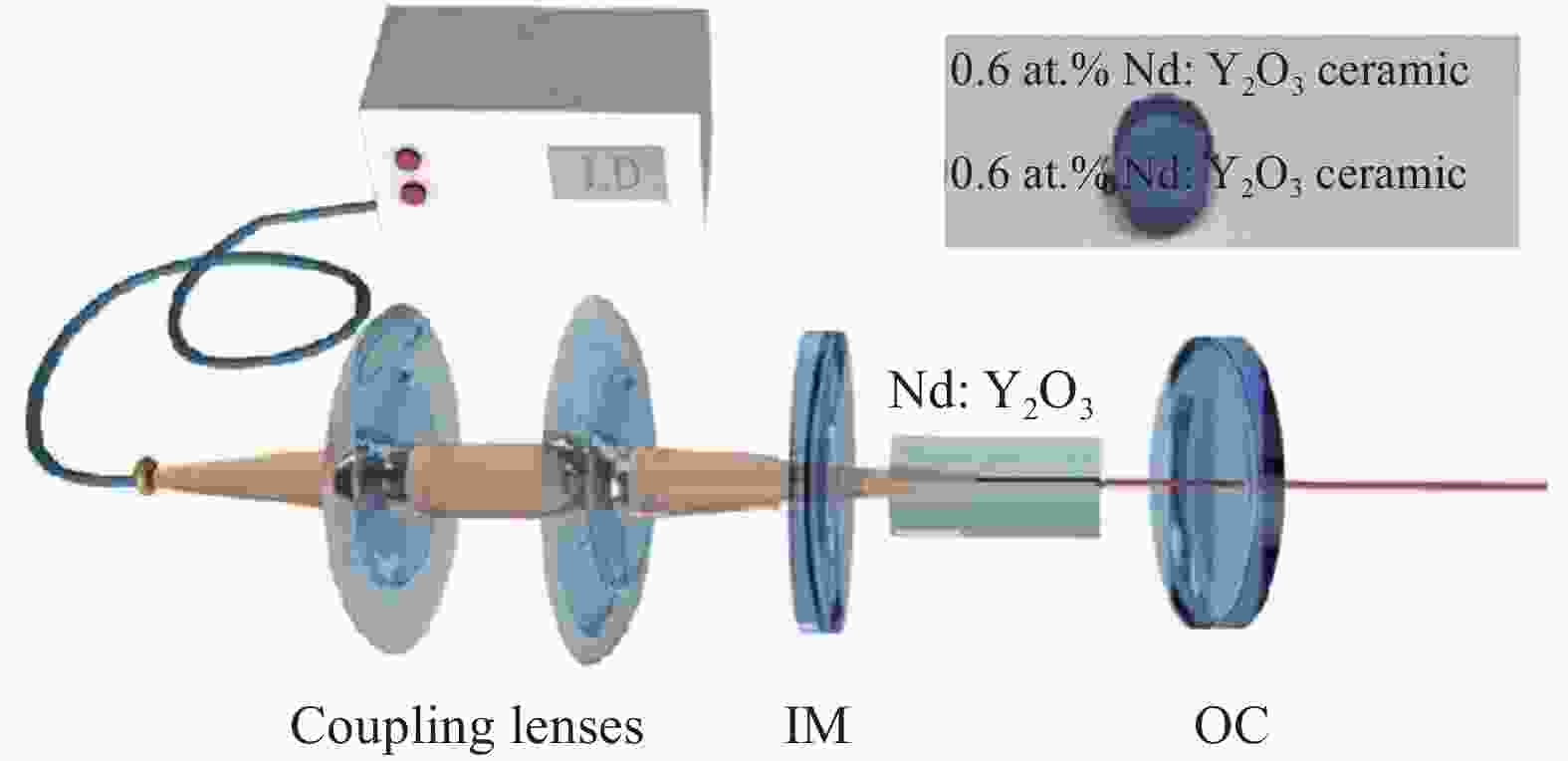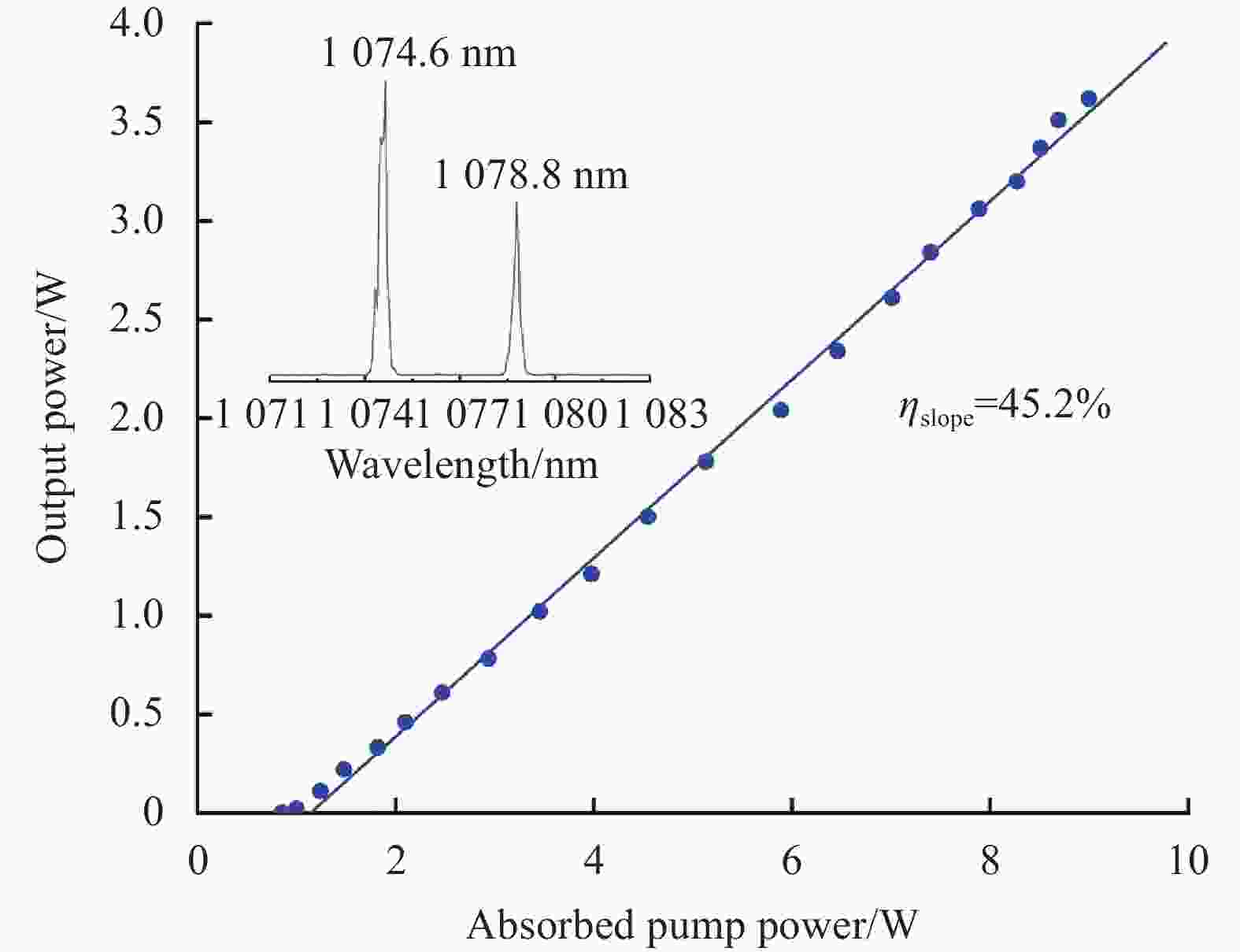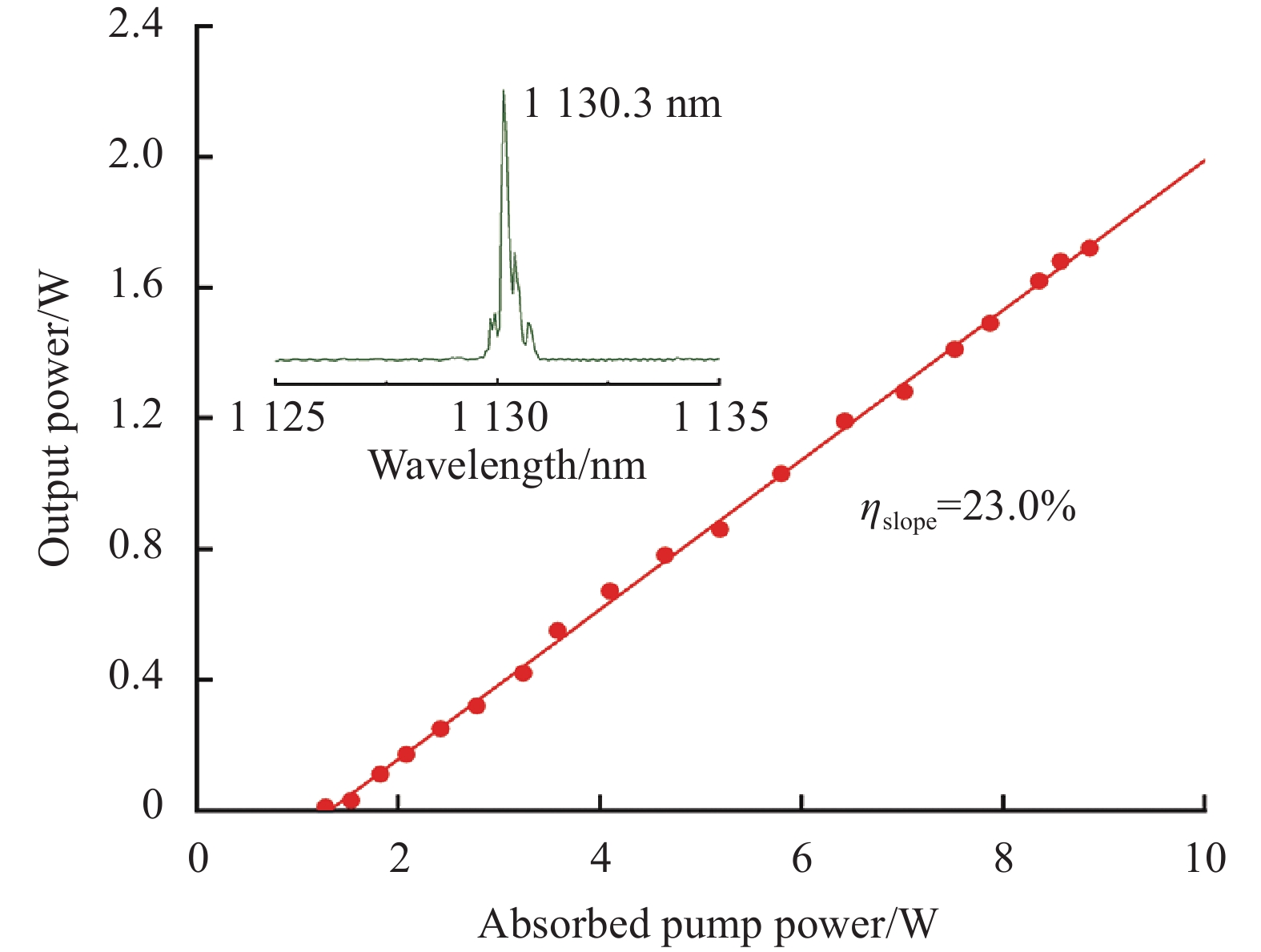-
透明陶瓷作为激光基质材料具备成本低、易生长、损伤阈值高等优良特性而被人们广泛关注[1-2]。1964年,Dy:CaF2陶瓷首次被证明了可作为激光增益介质[3]。激光陶瓷的制作工艺经过这半个世纪的发展,已能制作优良的激光基质材料,特别是其中的Nd:YAG陶瓷,可达到与晶体相媲美的光学质量和激光效率[4-5]。近年来,倍半氧化物(如Sc2O3、Y2O3、Lu2O3等)由于具有较高的热导率、比YAG基质更低的声子能量等优良特性,逐渐成为研究热点[6-8]。2001年,Lu等首次报道了基于Nd:Y2O3陶瓷的激光研究,并在742 mW的抽运功率下,得到最大160 mW平均输出功率、32%斜效率的1075 nm和1079 nm的双波长输出[9]。近些年,针对Nd:Y2O3的制作工艺和性能研究有较多报道[10-13],相关激光输出功率和效率普遍偏低。最近,江苏省先进激光材料与器件重点实验室采用真空烧结法结合热等静压技术制作的Y2O3透明陶瓷获得较好的光学质量和激光特性[14]。2018年,笔者所在课题组采用该Nd:Y2O3陶瓷作为激光增益介质,在7.0 W的吸收抽运功率下,获得了最高输出功率为3.01 W、波长为1075 nm和1079 nm双波长激光输出,斜效率达49.6%[15]。1075、1079 nm的双波长激光频率间隔在太赫兹,所以在差频产生太赫兹、差分吸收激光雷达等领域具有潜在的应用[16-17]。
目前,针对Nd:Y2O3透明陶瓷的激光均以1075、1079 nm的双波长输出为主[9-10,14],而其4F3/2-4I11/2能级跃迁对应丰富的子跃迁,相关谱线与常见的Nd:YAG有很大差异,进一步对其光谱和激光研究可丰富固体激光波长。针对Nd:YAG材料中4F3/2-4I11/2能级跃迁对应的弱谱线激光研究较多。2012年,上海交通大学的Liu等采用侧面抽运Nd:YAG陶瓷,通过腔内插入标准具选择性地实现了1123 nm激光输出,在2 000 W的功率下得到了509 W的激光输出,光光转换效率达25.5%[18]。2013年,张华年等采用LD端面抽运Nd:YAG陶瓷,通过腔镜精确镀膜,在16.1 W的抽运功率下,获得3.43 W的1116 nm和1112 nm双波长输出,斜效率达23.7%[19]。2013年,笔者团队利用自主制作的Nd:YAG透明陶瓷,实现了12.5 W的1123 nm激光输出[20]。1.1 μm波段的激光在环境监测、激光频率转换等方面都有重要用途,比如可用于远程大气水汽浓度监测,作为掺铥激光器能级上转换的抽运源[21],进一步结合倍频可产生黄光激光输出[22-23]。
文中对采用真空烧结法结合热等静压技术制作的Nd:Y2O3透明陶瓷的4F3/2-4I11/2跃迁光谱和激光特性进行了研究。对比了Nd:Y2O3与Nd:YAG陶瓷的光谱差异,并进一步通过简单的平平两镜腔结构,结合输出镜片镀膜选择,对1.08 μm和1.13 μm激光进行实验研究。
-
Nd:Y2O3具有特殊的晶体结构(C2及C3i两个格位),导致其荧光光谱与Nd:YAG及其他钕离子掺杂增益介质材料存在较大差异。相关的荧光光谱已有较多报道。图1给出了文中实验所用Nd:Y2O3与Nd:YAG透明陶瓷4F3/2-4I11/2能级跃迁对应的荧光光谱。该4F3/2-4I11/2能级间跃迁由于斯塔克能级分裂产生有12个斯塔克分裂子跃迁,分别由4F3/2能级分裂的R1和R2两个子能级向4I11/2分裂的Y1-Y6六个子能级跃迁产生。参考文献[8]中给出了室温下Nd:Y2O3透明陶瓷4F3/2与4I11/2的精细分裂能级参数及跃迁关系。由于有些子跃迁光子能量比较相近,导致测量光谱上的重叠,所以在光谱图中能看到9个强度不均的波峰。对比两个陶瓷的荧光光谱可知,类似常见的钕离子掺杂的工作介质,两种陶瓷的最强增益跃迁均来自4F3/2-4I11/2能级跃迁,对应的荧光波长在1.0~1.1 μm波段。但Nd:YAG的跃迁发射谱线比较聚集,而且各谱线增益差异较大;而Nd:Y2O3的谱线则相对比较疏散,与Nd:YAG发射最强增益谱线在1064 nm不同的是,Nd:Y2O3两条有强度相当的最强谱线在1075 nm和1079 nm,分别由R2-Y1和R2-Y2斯塔克分裂子跃迁产生,在未加任何波长选择元件情况下,容易实现该双波长激光振荡。目前关于Nd:Y2O3陶瓷激光器的报道主要局限在这两个子跃迁对应的激光输出。此外,R1-Y6子跃迁的增益强度仅次于1075 nm和1079 nm两个最强跃迁,对应的谱线在1106 nm;R1-Y1和R1-Y2两个子跃迁也产生具有相当增益强度的1052 nm和1056 nm谱线。理论上结合标准具、光栅等波长选择元件可实现所有谱线的激光输出,但以上相关谱线与最强增益谱线在光谱上差异在20 nm左右,有望通过简单的腔镜镀膜实现增益控制实现对应波长的激光输出,杜绝额外的插入损耗。

Figure 1. Fluorescence spectra of 4F3/2-4I11/2 energy transitions for both Nd:Y2O3 and Nd:YAG ceramics at room temperature
除了增益较强的谱线,对增益较小的谱线也有利于丰富固体激光波长,比如Nd:Y2O3的R2- Y6跃迁产生的1130 nm谱线与1074.6 nm和1078.8 nm两条谱线相距最远,与Nd:YAG的1123 nm跃迁波长类似,也具备通过腔镜镀膜控制产生激光的条件,而且该波长的倍频可获得565 nm波长的黄光激光。
-
在对4F3/2-4I11/2能级跃迁光谱分析基础上,笔者结合实验室现有激光腔镜,对Nd:Y2O3陶瓷的1075 nm和1079 nm两个最强谱线和1130 nm弱谱线激光进行研究。实验中采用半导体激光端面抽运的紧凑型平平两镜腔结构,装置示意图如图2所示。由江苏省先进激光材料与器件重点实验室基于真空烧结法结合热等静压技术制作的Nd:Y2O3陶瓷,晶粒尺寸均匀,没有发现粒间孔和粒内孔,具有优良的光学均匀性, 3 mm厚的该样品对1 000~2000 nm波段的透过率均在81%以上。实验中,加工了尺寸为3 mm×3 mm×5 mm,5 mm长的通光方向端面平行抛光未镀膜的Nd:Y2O3陶瓷作为增益介质。将该陶瓷用铟箔包裹,并置于用循环水控温的冷铜块内,使其表面温度保持在20 °C。

Figure 2. Experimental diagram of the diode end-pumped Nd:Y2O3 ceramic laser setup(IM: pump incident mirror, OC: laser output mirror)
抽运源为输出波长随功率变化在803~808 nm范围内的光纤耦合半导体激光器,其光纤数值孔径为0.22,芯径为200 µm。抽运光通过一对耦合透镜(两透镜焦距分别为50 mm和80 mm)会聚成一个束腰直径为320 µm的光斑,入射到Nd:Y2O3透明陶瓷中。由抽运光输入镜IM和激光输出镜OC组成简单紧凑的平平腔结构,腔长约15 mm。输入镜IM镀有对808 nm的抽运光高透并且对1000~1200 nm高反的膜系。输出镜OC分别采用对1.08 μm和1.13 μm波段激光部分透过的镜片,实现1075 nm和1079 nm激光输出和1130 nm的激光输出。采用型号PM310D(Thorlabs 公司)的光功率计对激光输出功率进行测量。为减少抽运光对激光输出功率测量结果的影响,实验中拉长功率计与输出镜OC的距离,保证剩余抽运光功率扩散后对激光输出功率的影响忽略不计。通过对入射抽运功率和激光运行下的剩余抽运功率测量计算得到吸收抽运功率。
-
前期采用透过率10%~50%之间的不同输出镜片对Nd:Y2O3陶瓷的激光性能进行了研究[15],表明采用对1.08 μm透过率为10%左右的输出镜片获得最高的转换效率。因此,文中实验中直接采用该10%透过率镜片对5 mm长Nd:Y2O3陶瓷1075 nm和1079 nm激光进行研究,得到的输出功率随吸收抽运功率的关系如图3所示。在9.0 W的吸收抽运功率下,获得了最高输出功率3.64 W、转换效率达40.4%的激光输出,拟合得到斜效率为45.2%。结果表明转换效率和斜效率略低于参考文献[15]中采用3 mm长陶瓷的43%和49.6%,但更长的增益介质,获得更多吸收,从而获得更高的输出功率,激光阈值约为0.8 W左右。使用光栅单色仪(ZOLIX,型号Omini-λ500)扫描输出激光光谱,测得阈值附近的激光为1074.6 nm单波长。随着抽运功率的增加,1078.8 nm激光起振。在最高输出功率时对应的1074.6 nm和1078.8 nm的双波长激光光谱如图3所示。由于两个波长激光光谱上较为靠近,未能对不同波长功率进行分别测量,只给出双波长总输出功率曲线,但从光谱图中可以看出1074.6 nm的谱线强度略高于1078.8 nm,这是由于1074.6 nm波长的激光阈值比1078.8 nm低,但随着吸收抽运功率的进一步提高,1078.8 nm的谱线强度能达到与1074.6 nm谱线相当。
为进一步实现1130 nm波长激光输出,输出镜片OC改用对1.13 μm透过率2%,同时对1.08 μm透过率约为90%的镜片,以抑制1075 nm和1079 nm两条最强谱线在腔内形成振荡。该镜片的透过率参数如图4所示。对装置调整优化后测量其输出功率和激光谱线结果如图5所示。光栅单色仪从1 000 nm测到1150 nm,未测到最强增益谱线对应的1075 nm和1079 nm激光,获得了1130 nm单波长激光输出,中心波长1130.3 nm, 线宽0.29 nm。激光阈值对应的吸收抽运功率为1.2 W。在8.86 W的吸收抽运功率下,实现了最高功率1.72 W激光输出,斜效率23.0%,转换效率19.4%。
-
文中对采用真空烧结法结合热等静压技术制备的Nd:Y2O3透明陶瓷的荧光光谱特性及相关激光输出特性进行了研究分析。对比了Nd:Y2O3与Nd:YAG透明陶瓷的4F3/2-4I11/2跃迁光谱,表明Nd:Y2O3陶瓷荧光光谱存在着多个增益相当的谱线,更有利于实现双波长激光振荡,而且不同子跃迁光谱上的离散特性更有利于通过控制简单腔镜镀膜获得丰富的1.0~1.1 μm波段激光。进一步通过简单的平平两镜腔结构,结合输出镜片镀膜选择,对1.08 μm和1.13 μm波段激光进行实验。在9.0 W的吸收抽运功率下,获得了输出功率3.62 W、转换效率40.4%的1074.6 nm和1078.8 nm双波长激光输出;在8.86 W吸收抽运功率下,获得了输出功率1.7 W、转换效率19.4%的1130.3 nm连续波单波长输出。实验证明了Nd:Y2O3透明陶瓷是一种优良的激光增益介质,此外进一步通过腔镜镀膜的设计,可望获得1052 nm和1056 nm双波长和1106 nm等新型波长的激光输出。
4F3/2-4I11/2 transition spectra and high efficient laser operation of Nd:Y2O3 transparent ceramic
doi: 10.3788/IRLA20210601
- Received Date: 2021-08-24
- Rev Recd Date: 2021-10-27
- Accepted Date: 2021-11-04
- Publish Date: 2022-07-05
-
Key words:
- Nd:Y2O3 /
- laser transparent ceramics /
- dual-wavelength /
- 1 130 nm laser
Abstract: The fluorescence spectra and laser operation of Nd:Y2O3 transparent ceramic fabricated by the vacuum sintering plus hot isostatic pressing method were reported. By comparing with the fluorescence spectra of Nd:YAG transparent ceramics, it is shown that the 4F3/2-4I11/2 transition spectra of Nd:Y2O3 transparent ceramic have multiple spectral lines with similar gain, which is more beneficial to realize simultaneous dual-wavelength laser oscillation. The spectra discrete characteristic among different Stark transitions of Nd:Y2O3 transparent ceramic was beneficial to obtain abundant wavelength lasers around 1.0-1.1 μm through the cavity mirror coating to control the loss of different wavelengths. Furthermore, a simple plane-plane cavity was used, and the output coupler with reasonable coating design was selected for different wavelength laser output. The maximum output power of 3.62 W and the conversion efficiency of 40.4% were obtained for the 1074.6 nm and 1078.8 nm dual-wavelength laser output. The output power of 1.7 W and the conversion efficiency of 19.4% were achieved for 1130.3 nm laser output.













 DownLoad:
DownLoad:



